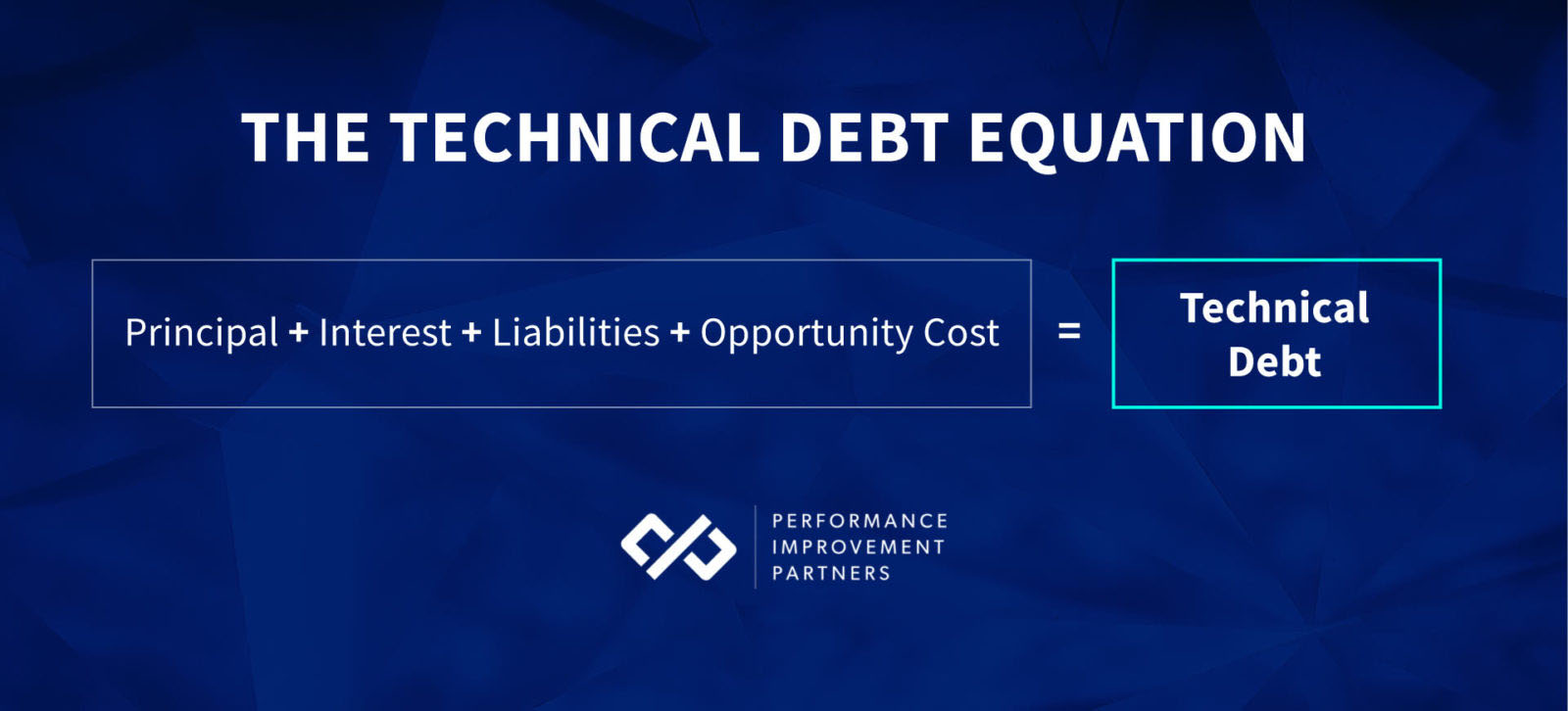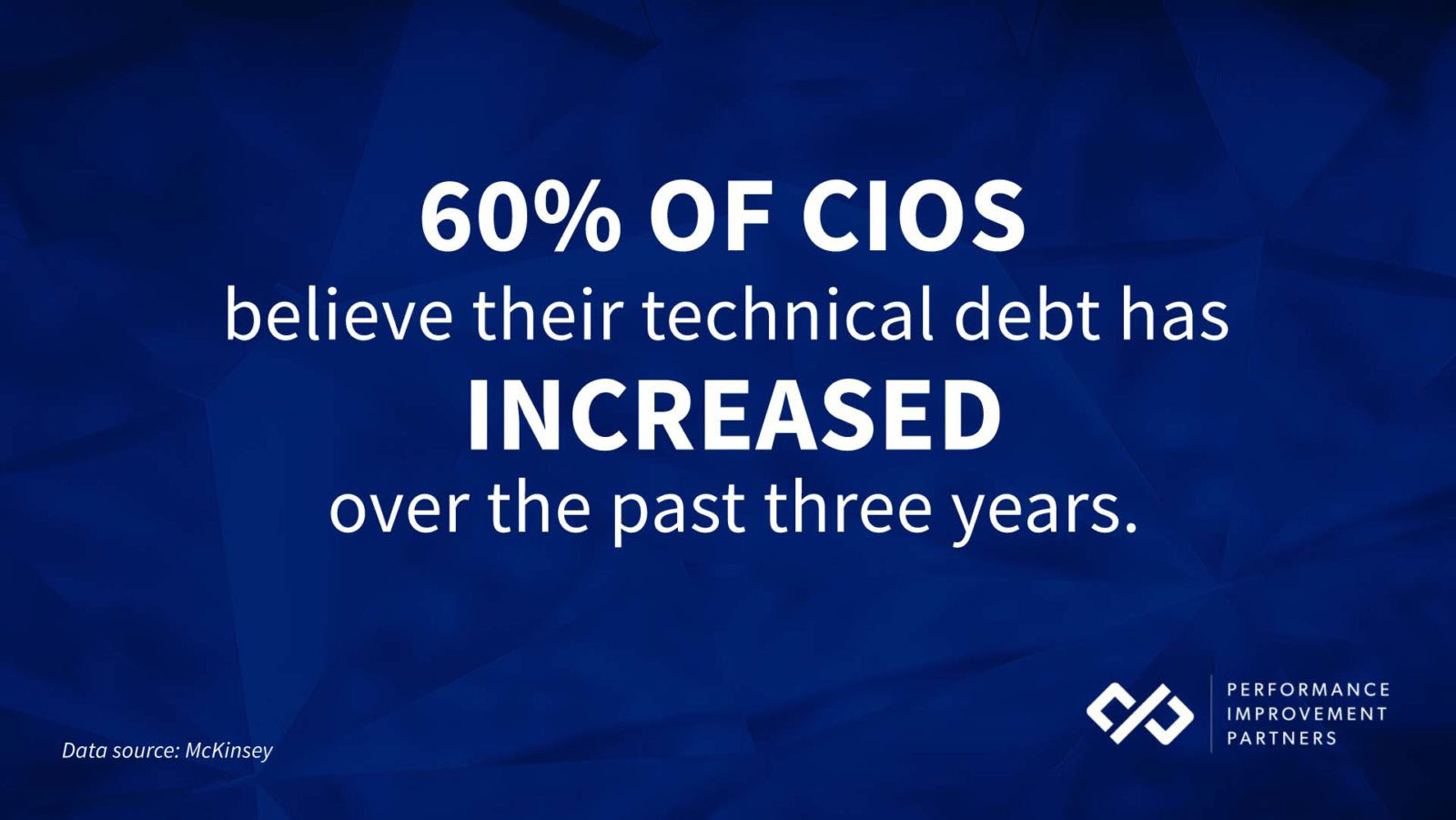Similar to any credit card, the bill for a company’s technical debt will always come due.
And, just like credit card bills, it’s wise to pay your bill promptly. Instead of interest charges, failure to keep your technical debt in check leads to downtime from outages, lost efficiency, and cybersecurity risks that can have detrimental results.
Yet, technical debt is often overlooked – even when Private Equity firms are assessing acquisition targets – leading to unanticipated costs and roadblocks when looking to enact value creation plans.
Firms who understand, and know how to calculate this debt, have added insights to guide strategic investment decisions. Developing clear processes to assess technical debt and ongoing infrastructure management sets PE firms up for success.
The following insights are designed to help PE firms to understand technical debt and what it means for future investments and business growth:
| DEFINITION: What is technical debt? |
| EXAMPLES: Examples of tech debt |
| MEASUREMENT: How to measure technical debt |
| MINIMIZING RISK: Ways to reduce IT debt |
What is Technical Debt?
Technical debt (also known as tech debt or IT debt) is created as IT hardware and software solutions age, or when technology decisions are made that focus primarily on the short term. Changing solutions, refactoring applications, and updating outdated technology all come at a cost, and are often delayed in favor of business activities with results that are more visible or more immediate.
In relation to software or application development, code debt is often the result of development teams rushing to meet a deadline, and, as a result, executing an easier option which may lead to additional work down the road.
In regards to IT infrastructure, tech debt is often the result of under-investing in hardware, software and IT governance, including a company’s technology training and processes.
For example, if your computers are 5 years old but you continue to defer updates and maintenance (and supported systems for those machines become few and far between), you are carrying the burden of technical debt.
As Fred Purdue, Infrastructure Practice Manager at Performance Improvement Partners says, “Companies can’t see technical debt, but those who ignore it often pay the price. From lost productivity, downtime and the loss of data, through to security incidents that compromise company systems and intellectual property, letting IT debt accumulate often results in detrimental impact to business growth.”
“Companies can’t see technical debt, but those who ignore it often pay the price. From lost productivity, downtime and the loss of data, through to security incidents that compromise company systems and intellectual property, letting IT debt accumulate often results in detrimental impact to business growth.”
– Fred Purdue, Infrastructure Practice Manager, Performance Improvement Partners
On a credit card statement, the interest on monies owed is displayed as a line item that must be paid – an unnecessary cost if the bill is paid promptly. In the same vein, money spent on interest can’t be put towards accounts that drive more value over time, such as an IRA or 401k.
There is no monthly statement for technical debt. As a result, the impact of lost opportunities or devalued systems do not show up until the technical debt has reached its breaking point.
Examples of Technical Debt
Technical debt spans all areas of business—from infrastructure, to operations, to business intelligence. It applies to a range of technologies including software, hardware, networking, operations, and cybersecurity.
Technical debt examples include:
- Outdated point of service (POS) systems that are not compatible with software updates or need to be patched to run
- Old versions of Windows that no longer support updates or have customer support, leaving the company vulnerable to cyberattacks
- Computers that are more than five years old and take too long to boot up, don’t support internal systems, or slow down team productivity
- Enterprise Resource Planning (ERP) systems that have passed their end of support life and are no longer eligible for upgrades or customer support
- Data discovery tools or data warehouses that no longer integrate with current systems reducing the efficacy of your business intelligence
Since technical debt isn’t readily seen, there is danger of leaving technology systems untouched, creating larger unwanted business impact down the road.
Types of Tech Debt
Given the many types of technical debt, it’s beneficial to break it down into three categories:
IT Infrastructure Debt
Eliminating IT infrastructure debt often comes down to modernizing physical infrastructure or software, working through cloud migrations, or eliminating this tech debt by moving it to an OpEx model which spreads the cost out in a recurring cost structure or subscription.
Operational Debt
While operational debt tends to be addressed on a more regular basis, areas of it are often overlooked. As Purdue mentions, “Companies focus on opex carrying cost around areas such as licenses and warranties, but ignore other areas — such as policies and procedures and cyber risk management – which impact the operational maturity and business controls of IT debt.”
Business Intelligence Debt
Predictive analysis and business intelligence systems are only as good as the data provided. If those systems are outdated, or the data is not structured in a way that provides meaningful insight, you can find yourself in debt. Evaluate BI and reporting to minimize the interest in liability, such as ERP systems, data warehouses, physical storage, backup and redundancy solutions, and business reporting systems.
The Risk of Ignoring Technical Debt
Ignoring technical debt leads to long-term disadvantages that put the business – and value creation plans – at risk. Eventually, the hardware may stop working, systems can crash, or ransomware incidents occur because the tech is outdated.
At that point, it’s not only a budget issue (do you have the wherewithal to replace everything at once?) it’s a productivity and security issue that can have catastrophic implications to your value creation plans — and the business itself.
It’s not only a budget issue; it’s a productivity and security issue that can have catastrophic implications to value creation plans.
It’s a point that has been proven by the headlines, as demonstrated by an NBC news article stating that “America’s cyberwarriors are spread thin by attacks” and “barely able to keep up.”
Recent attacks which could have been avoided by addressing technical debt include:
- The March 2021 Microsoft data breach put over 60,000 businesses at risk
- The Colonial Pipeline attack on May 7, 2021, affected the tens of millions of Americans relying on the pipeline, causing Colonial Pipeline to pay $4.4 million to the hackers who broke into their system.
- The first week of June 2021, more than 50% of the U.S.’s ability to process beef ground to a halt in the first week of June 2021 due to a ransomware attack.
- On July 2, 2021, one of the “largest criminal ransomware sprees in history” occurred when global IT infrastructure provider Kaseya was hacked – a supply chain attack that infected over 1,500 companies z
“Many of these situations come from not being proactive in addressing technical debt vulnerabilities. The debt is seen as maintenance — and you don’t get an ROI on maintenance. You don’t get to pay less for a car because you got its oil changed. You pay for the oil change as part of the car’s standard maintenance, reducing the risk of breakdowns and other repairs. This is how PE Firms need to address portfolio company technical debt,” says Purdue.
Private Equity Firms in particular face additional risks when not considering technical debt in relation to the investment lifecycle. From unexpected costs to the inability to enact value-creation plans, IT debt plays an imperative role in any mergers and acquisitions strategy.
Don’t let unidentified technical debt derail your investment thesis:
Defend your VCP with a due diligence that moves at the speed of Private Equity.
The first, and most important step, is to understand how much debt a target company has by conducting technical diligence before the acquisition.
How to Measure Technical Debt
Technical debt can be measured as the sum of your principal, interest, liabilities, and missed opportunity costs.
These four elements of the technical debt equation are defined as:
Principal
Likely the easiest part of the technical debt equation to realize, this is the cost to maintain outdated legacy systems, recurring system issues, and broken hardware. How much has the deferred updates in IT accumulated and how much will it cost to fix those?
Interest
The more time IT teams spend maintaining old and outdated IT assets and applications, the more interest the technical debt accrues. Simply put, if you keep putting off updates and replacements, you’ve compounded interest and will end up paying more in the long run to replace those elements when the time comes.
Liabilities
Think of liabilities as indirect business costs such as outages, security vulnerabilities, or interruptions to business operations — these are significant elements of technical debt. If hardware or software is not replaced or maintained, those items are no longer secure. In turn, significant cybersecurity liabilities or outage liabilities ensue, making it harder for IT to secure those systems from disruption or third-party attacks.
Opportunity Costs
When technical debt is not addressed, the opportunity cost is realized through the time and money lost to inefficient and ineffective processes. Once the need to address IT debt is discovered, not only is time lost maintaining and troubleshooting outdated technology, but budget earmarked for other value-creation activities must be reallocated.
As a result, the inability to execute your value creation plan, missed opportunities to maximize investments, and delays in portfolio company growth can all deter company growth when continuing to work through dated infrastructure, software, and systems.
How to Reduce IT Debt
Overall, technical debt is on the rise with 60% of CIOs reporting that their technical debt has increased over the past three years.
Nearly every company has technical debt. Knowing how to identify it, plan for it, and develop strategies to manage it is what sets apart the companies driving maximum value.
Purdue reminds PE firms that, “It’s not always about eliminating the principal. Sometimes, reducing technical debt is about eliminating the liability (interest) that it carries.” Regardless, there are steps to take for setting processes for managing technical debt on an ongoing basis.
“It’s not always about eliminating the principal. Sometimes, reducing technical debt is about eliminating the liability (interest) that it carries.”
Planning is key. “The easiest way to find yourself with a large amount of technical debt is to operate without a plan,” states Purdue. “The second way is to focus on IT investments that carry an ROI. Most companies will say that IT investments carry ROI, but many of them do not. It’s about risk management and risk reduction.”
Think about what part of your budget is allocated to keep the business—and IT infrastructure—current. Ask yourself:
Do you have a plan?
Assess and review your IT roadmap to develop a plan for moving forward. This may mean working toward tech debt reductions or setting key timelines and milestones for when key elements need to be reviewed, updated, or replaced. Enlist the guidance of a third-party partner for an assessment of technical debt and build a 3 to 5-year IT roadmap and action plan to manage technical debt and related risk.
Does your plan take risk management into account?
Are you deferring costs? If you are, where and how are you tracking those? These deferred costs – such as those related to outdated IT infrastructure – must be planned for when looking ahead to next year’s budget.
Remember – the risks surrounding IT debt affect more than the P&L, they can be detrimental to your business as a whole. Should a successful cyber attack occur, the liabilities of the cyber breach fall squarely on the shoulders of company leadership.
Where in your budget have you accounted for your debt?
Do you have an IT balance sheet? If you removed items from your budget, where did you put them? Make a plan to replace items and build those replacement timelines and costs into your budget before your debt gets too high.
Overcome Technical Debt to Outsize Outcomes
Just like any invoice, the bill for technical debt will eventually come due.
Planning ahead will ensure you have the resources to pay that debt off in a timely manner and execute a strategy for management over time.
Discover how much technical debt target companies have with a value-driven approach to IT due diligence. Then, start your technology transformation with an IT roadmap and for a pragmatic, step-by-step approach to outsizing outcomes with technology.
MAP THE PATH TO MAXIMUM VALUE CREATION





